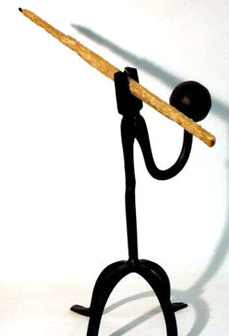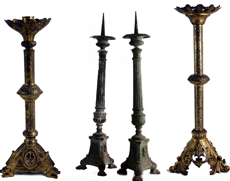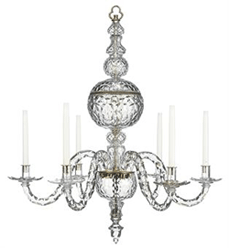From fish oil to chandeliers: early domestic lighting
Karen Wallis-Smith offers some insight into the ways we used to light our houses before electricity

The truth of early domestic lighting is that there wasn't much for many centuries. From prehistoric times to the Middle Ages, the central hearth was the hub of family life in both humble homes and grand halls. As the main source of light, as well as heat, open fires were essential; unfortunately the smoke was rather unappealing.
Stones or shells, filled with animal fat or fish oil and lit using a fibrous wick, were exploited to craft the earliest lamps; an idea the Romans developed into hand lamps which, in turn, gave rise to the candle. Yet, preceding the candle, the most common form of early domestic lighting, was the rushlight.

Rushes were dipped into bacon or mutton grease and held in the jaws of an iron holder to be burnt. In the 17th century rushlights were used by the rich and poor alike, but by the 18th century they were considered the poor man's candle, being cheap and easy to make, and not taxed under the 1709 tallow candle tax. Having a different meaning to that used today, the familiar expression, ‘Burning the candle at both ends', originally came from the extravagant practise of lighting both ends of a rushlight to emit more light, thus causing it to burn twice as fast.
* Subscribe to Country Life and save 40%
The craft of making tallow candles began in England in the 13th Century. The wick was repeatedly dipped into melted tallow to build up a candle. A good quality candle was made from sheep's and cow's tallow, whereas the cheaper pig fat candles, used by the poor, smelt foul and gave off thick black smoke. Tallow chandlers were granted a Royal Charter by Edward IV, in 1462 and the trade was carefully monitored and, later, highly taxed.

Candles were early status symbols; their usage provided an insight into a household's wealth and status. Beeswax candles were the prerogative of the Church, Royalty and nobles for centuries until 1860 when paraffin wax candles and industrialisation made them available to the masses.
The 18th century proliferation of craftsmen saw spectacular light fittings emerge in which to burn the precious candles, including the most luxurious of them all; the cut-glass crystal chandelier. An affluent Georgian homeowner would use an extravagant abundance of wax candles for entertaining, but may well be found working by the combined light of the hearth and a tallow candle when guests were not expected.
Exquisite houses, the beauty of Nature, and how to get the most from your life, straight to your inbox.

The rush of domestic lighting inventions in the late 18th to early 19th centuries significantly improved domestic lighting for the wealthy - the unfortunate poor were to rely on fire and rushlights until Victorian times.
This article was written by Karen Wallis-Smith, who owns Fritz Fryer Antique Lighting who offer an extensive lighting sales, design and consultancy service, specialising in the high quality restoration of period fittings. They also work with private and commercial clients to create sympathetic lighting solutions for period properties and their on-site workshop repair all fittings, by hand, to the highest possible standard.

This is an article from ProjectBook which provides a wide range of information for the conservation, restoration, care and repair of period and listed buildings. Fritz Fryer Antique Lighting is a member of the Heritage Register which contains over 500 vetted craftsmen, contractors and consultants from all over the UK. Updated daily with new content, the website features the heritage register, a products directory, informative articles, current news, events and more. For more information, visit www.projectbook.co.uk
Country Life is unlike any other magazine: the only glossy weekly on the newsstand and the only magazine that has been guest-edited by His Majesty The King not once, but twice. It is a celebration of modern rural life and all its diverse joys and pleasures — that was first published in Queen Victoria's Diamond Jubilee year. Our eclectic mixture of witty and informative content — from the most up-to-date property news and commentary and a coveted glimpse inside some of the UK's best houses and gardens, to gardening, the arts and interior design, written by experts in their field — still cannot be found in print or online, anywhere else.
-
 Child stars, Prince and nursery rhymes: It's the Country Life Quiz of the Day, December 5, 2025
Child stars, Prince and nursery rhymes: It's the Country Life Quiz of the Day, December 5, 2025It's all in today's quiz.
By Country Life Published
-
 ‘Calf’s brains have a bland, gentle richness that soothes and cossets': Tom Parker Bowles on the joys of eating offal
‘Calf’s brains have a bland, gentle richness that soothes and cossets': Tom Parker Bowles on the joys of eating offalEating offal it is more sinned against than sinning, but it offers the ultimate in magnificent, fully immersive eating.
By Tom Parker Bowles Published

